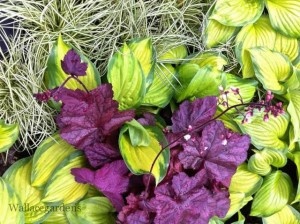
What makes some container garden designs sing and sparkle, while others seem to fizzle out? For answers, Seasonal Wisdom turned to horticulturist and garden designer Nancy Wallace, who designs more than 300 containers a year for her clients in the Atlanta-Metro area (Zone 7B).
This stunning full shade container is one example. It features Carex ‘Evergold’ (upper left); Hosta ‘June’ (left and right) and Heuchera x villosa ‘Beaujolais’. This pro agreed to share some of her growing secrets and sensational container garden designs with us. Take a peek…
This story began a couple years ago, when Seasonal Wisdom met the friendly and talented garden designer via Twitter. We later got to know each better over Pinterest and Facebook. Wallace has an impressive Instagram following too.
Have Fun with Colors
Over time, I became impressed by Wallace’s creative container garden designs, which often feature contrasting colors, interesting textures and clever plant choices. That’s why I wondered if she’d share tips with Seasonal Wisdom. She agreed, and said her designs often have a lot to do with lemonade and grapes.
Well, not really, but …
“Lemonade and Grape is one of our theme garden collections,” explains Wallace, who offers her clients themed containers with names like Sugar and Spice, Foliage Frenzy and Chocolate Mint. “I like the idea of theme gardens, because it helps explain the color concept easily. It’s a fun way to play with plants and allows me to keep track of which plants work well together.”
In Lemonade and Grape designs, “lemonade” refers to lemon-yellow plants with shades of green. “Grape” refers to violet, fuchsia and blue tones. On a color wheel, these colors are opposite each other and provide a dramatic contrast.
“Texture and color are equally important to me,” says Wallace. “I use lots of foliage plants in combination with flower colors.”
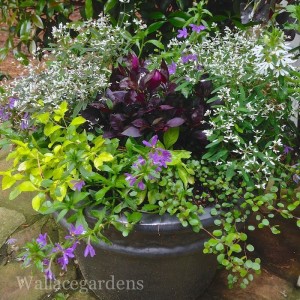 The above Lemonade and Grape planter features (clockwise from top left): Euphorbia ‘Euphorbic White’ (new); blue Scaevola; Euphorbia ‘Euphorbic White’; white Scaevola; wire vine; blue Scaevola; Duranta ‘Cuban Gold’; and blue Scaevola.
The above Lemonade and Grape planter features (clockwise from top left): Euphorbia ‘Euphorbic White’ (new); blue Scaevola; Euphorbia ‘Euphorbic White’; white Scaevola; wire vine; blue Scaevola; Duranta ‘Cuban Gold’; and blue Scaevola.
In the center is Alternathera ‘Little Ruby’, which will grow 12 to 14 inches tall and become the container’s centerpiece. These plants thrive in hot humid climates in full sun to part shade.
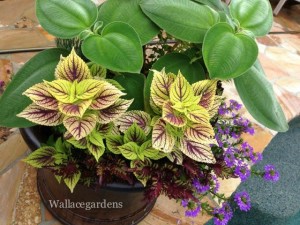 A Good Container Keeps Performing for Months
A Good Container Keeps Performing for Months
Ideally, container garden designs should look good from the time they’re planted in the spring, until the first hard frost. “A key component for every container I create is the ability of those plants to grow and thrive from the date of installation, until their removal six months later,” says Wallace.
The above container is a perfect example. Clockwise from top: Tibouchina grandiflora (princess flower); Scaevola; Coleus ‘Caipirinha’ (middle) and Coleus Under the Sea ‘Lime Shrimp’ (lower).
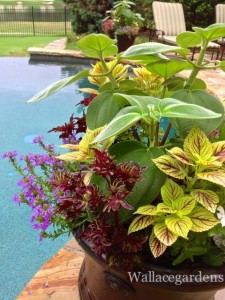 This poolside container garden design is shown here in summer, but by October, the princess flower will have pretty purple blossoms.
This poolside container garden design is shown here in summer, but by October, the princess flower will have pretty purple blossoms.
“Remember to choose the right plant for the right place,” says Wallace. “Take the time to make sure the location is suitable for the plant.” All of these beauties, for instance, grow well in full sun.
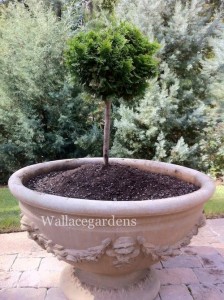 Anchor Plants and Big Planters
Anchor Plants and Big Planters
Many of Wallace’s larger planters start with an anchor item, which remains in the planter for several seasons. Above is a topiary conifer: Chamaecyparis obtusa.
“Use big planters, and buy the best quality you can afford,” advises Wallace. “Not only can you create more impact with a larger planter, but it will require less water. Whatever container you use, always make certain it offers excellent drainage.”
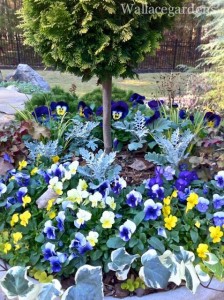 Here’s the same container in late fall. It was filled with foliage plants like dusty miller, Algerian ivy, and Heuchera ‘Beaujolais’, along with blue, purple and yellow violas. The next spring, the container was bursting with spring bulbs like tulips, hyacinths and daffodils, which bloomed in time for Easter. After they stop blooming, they are replaced with summer plants.
Here’s the same container in late fall. It was filled with foliage plants like dusty miller, Algerian ivy, and Heuchera ‘Beaujolais’, along with blue, purple and yellow violas. The next spring, the container was bursting with spring bulbs like tulips, hyacinths and daffodils, which bloomed in time for Easter. After they stop blooming, they are replaced with summer plants.
Wallace recommends investing in excellent quality potting soil, and replacing the soil every growing season for intensively planted containers. “Don’t reuse old potting soil,” she says. “I use two brands of soil, both locally produced here in Georgia. Providing a good home and proper nourishment to the root systems means everything to the success and longevity of the final product.”
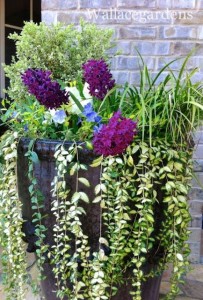 Above is a pretty spring container with variegated boxwood, Acorus grass, Vinca ‘Illumination’ (a variegated vine with blue flowers) and Hyacinth ‘Woodstock’, along with lemon yellow and white pansies.
Above is a pretty spring container with variegated boxwood, Acorus grass, Vinca ‘Illumination’ (a variegated vine with blue flowers) and Hyacinth ‘Woodstock’, along with lemon yellow and white pansies.
Throughout the growing season, don’t forget to water properly. “Not every container garden will need the same amount of water,” says Wallace. “Containers in full sun, or those exposed to wind, will need more frequent watering. Those in shade or sheltered locations will need less. Smaller containers need more water than larger containers too.”
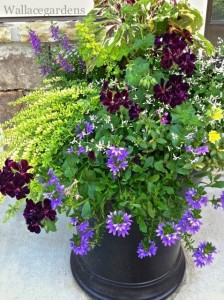 Lemonade and grapes are interpreted here (clockwise from top left) with purple Angelonia, Coleus ‘Mosaic’, Euphorbia ‘Diamond Frost’, Calibrachoa ‘Superbells Yellow’, Scaevola ‘New Wonder’, Geranium ‘Contessa Purple’ (Black Magic) and Lonicera.
Lemonade and grapes are interpreted here (clockwise from top left) with purple Angelonia, Coleus ‘Mosaic’, Euphorbia ‘Diamond Frost’, Calibrachoa ‘Superbells Yellow’, Scaevola ‘New Wonder’, Geranium ‘Contessa Purple’ (Black Magic) and Lonicera.
“Gardening is a lot like cooking,” adds Wallace. “Select good local ingredients and respect the basic rules of composition to insure the best possible results. But don’t hesitate to explore and take risks. You can still respect the rules of horticulture while playing with plants.”











{ 2 comments }
Nice post. Beautiful containers.
Love the colors! Would love to try this in my garden.
Comments on this entry are closed.